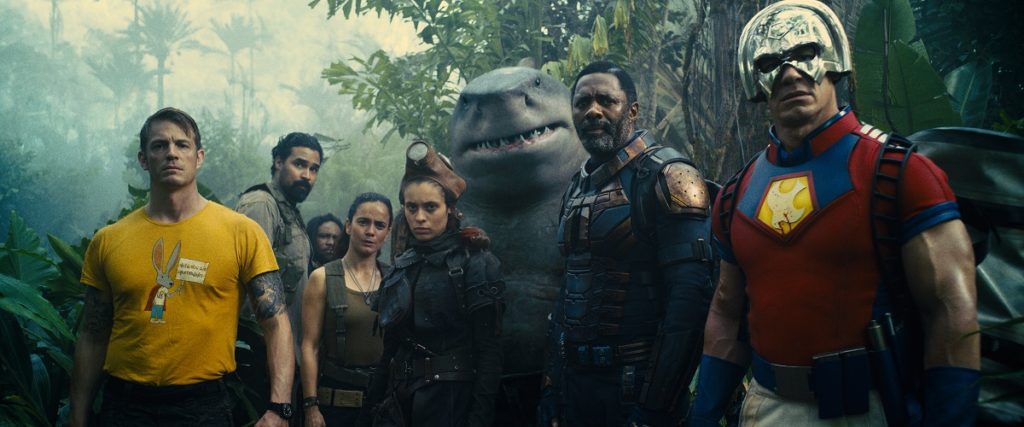
The Suicide Squad feels like the twilight of the age of superhero movies, making way for a new form of megablockbuster to exchange places. And if it turns out to be the final moment of light for the genre, it was one of the most unique and indefatigable outings it ever had.
A soft reboot from the 2016’s Suicide Squad, this entry reunites that film’s only surviving major characters: Harley Quinn (Margot Robbie) who needs no introduction; Rick Flag (Joel Kinnaman), the one morally straight member to walk alongside the scum of the DCEU; and the impossibly likable Amanda Waller (Viola Davis). Like the 2016 film, the Belle Reve prison members all have unique abilities and are given a chance to reduce the length of their incarceration by completing a mission. In this case, their mission is to eradicate all information about Project Starfish in the fictional island-nation of Corto Maltese, whose new president wants to use the mysterious weapon stored in an ugly concrete tower called Jotunheim against the United States.
Harley and Flag are joined by their capable leader Bloodsport (Idris Elba), who shoots bullets really well(?); the Madison Cawthorn-esque Peacemaker (John Cena); King Shark Nanaue (Sylvester Stallone), whose name says it all; a young woman who controls rats (Ratcatcher 2, played by the newcomer Daniela Melchior); and a nihilistic man with mom-problems who throws giant Skittle-like polka dots that grow on his skin (Polka Dot Man, played by David Dastmalchian). And yes, you read that last one correctly.
But the real star is writer-director James Gunn. He’s noted on social media several times that he’s never had more fun working on a film than on The Suicide Squad, and it shows. This is the most fun I’ve had watching a superhero movie, full stop. The fun is largely catalyzed from the combination of Gunn’s humor being a better fit with the DCEU than with the MCU (since the former filters him less) and the writing’s self-awareness of the stupidity of the entire genre of superhero movies. Nothing captures Gunn’s genre consciousness more than the movie’s necessary, potentially world-ending cataclysmic CGI threat that needs eliminating: a giant alien starfish, not unlike an evil Staryu.

KING SHARK in Warner Bros. Pictures’ superhero action adventure “THE SUICIDE SQUAD,” a Warner Bros. Pictures release.
Gunn’s creative sensibilities come through clear and strong, perhaps solidifying the case that he meets Andrew Sarris’s definition of an auteur. The lead characters of opposing genders don’t couple by the end, color is used more carefully than in any other non-James Gunn-made superhero movie, death means something in a genre that is anti-death. Like Gunn’s other big-budget movies, tone takes precedence over strict plot organization; some scenes could, and perhaps should, be omitted from the perspective of plot and story structure, but are kept for the sake of tone, such as the entire first 10 minutes that do nothing structurally.
Another great example of this comes in one scene when the squad is split into two groups while inside Jotunheim. The activities of the two groups are shown separately, divided by just a title card saying “eight minutes earlier,” rather than edited together à la Christopher Nolan. Since the activities of the two affect each other, the narrative does not require them to be separated, and it would actually be more conventional had they not been. But the way they are divided allows for a tonal sequencing from serious to comedy to serious to uber-serious that the more conventional editing would have denied.
Most importantly, it looks amazing. Cinematographer Henry Braham, whose biggest titles are only Gunn’s second Guardians and The Golden Compass (2007), shot in IMAX and managed to make every frame more popping and with deeper blacks than nearly every Marvel movie. Braham and Gunn also shot Harley in a way respectful to Margot Robbie’s agency, unlike the 2016 film, and in one sequence wonderfully subvert the damsel in distress trope. When the camera lingers on bodies, they tend to be male bodies, such as that of Corto Maltese’s President Silvio Luna, played by the lusty Juan Diego Botto.
The Corto Maltesean President’s anti-American imperialism isn’t the only political beat. Avoiding spoilers, two members of the squad (whom I won’t name) uncover something shady about Project Starfish involving the United States government and conflict about the nature of whistleblowing. The filmmakers are clearly on the side of the character in favor of sharing the negative information about the United States’ past with the public, an obvious political messaging that leans into the same territory as public discourse about “critical race theory” or the New York Times’s “1616 Project.”
More interesting than the unapologetic politics of this character conflict is the connection to Gunn, who has also been the center of a controversy about negative information from the past with lingering impacts on the present. Gunn had publicly repented for nearly decade-old distasteful and offensive tweets many years before alt-right journalist hack Mike Cernovich resurfaced the tweets, retaliating against Gunn for attacking a few of Cernovich’s fellow conservatives on the same website. And even though Cernovich’s work was a political spite to put him underwater at Disney, Gunn—in his newest movie as well as in the 2018 controversy—doesn’t want to hide his past transgressions, even when they make ourselves and the people or institutions we love look like shit.
The Suicide Squad
2021
dir. James Gunn
132 min.
The Suicide Squad is available in theaters and for streaming on HBO Max on August 5.

